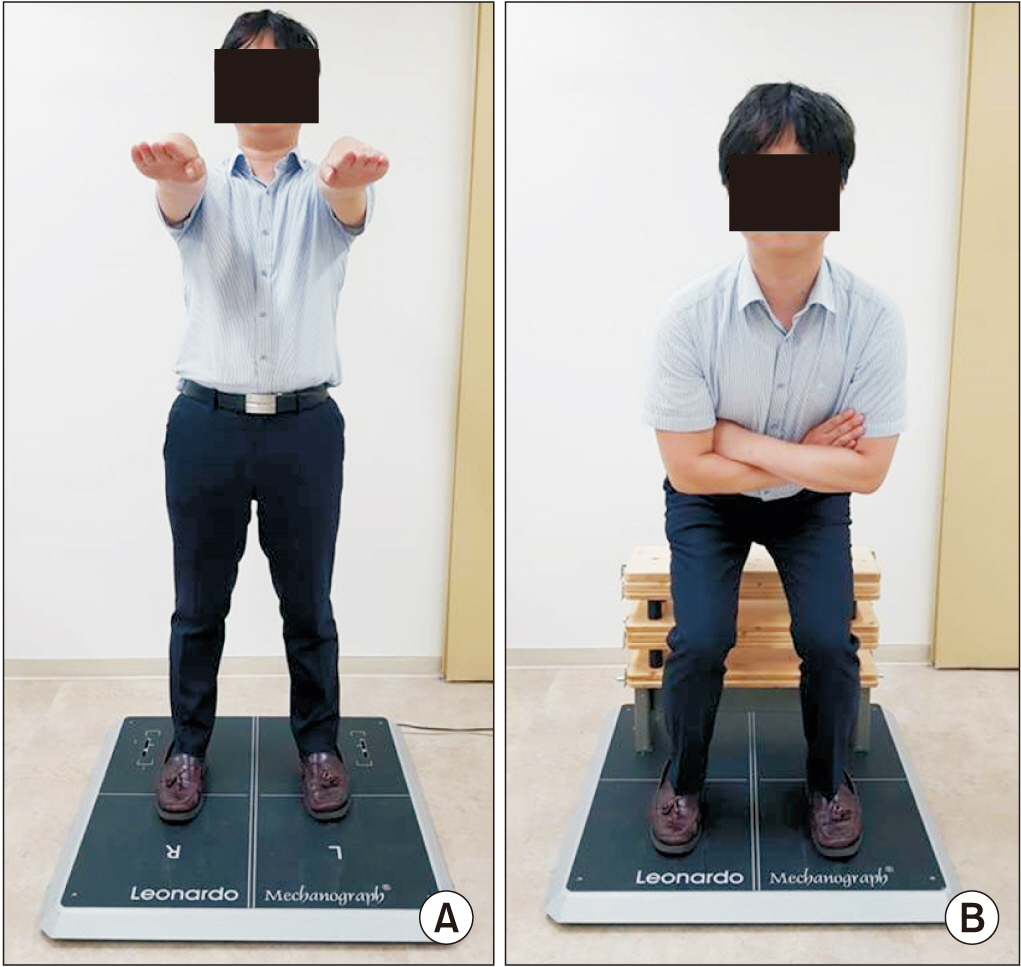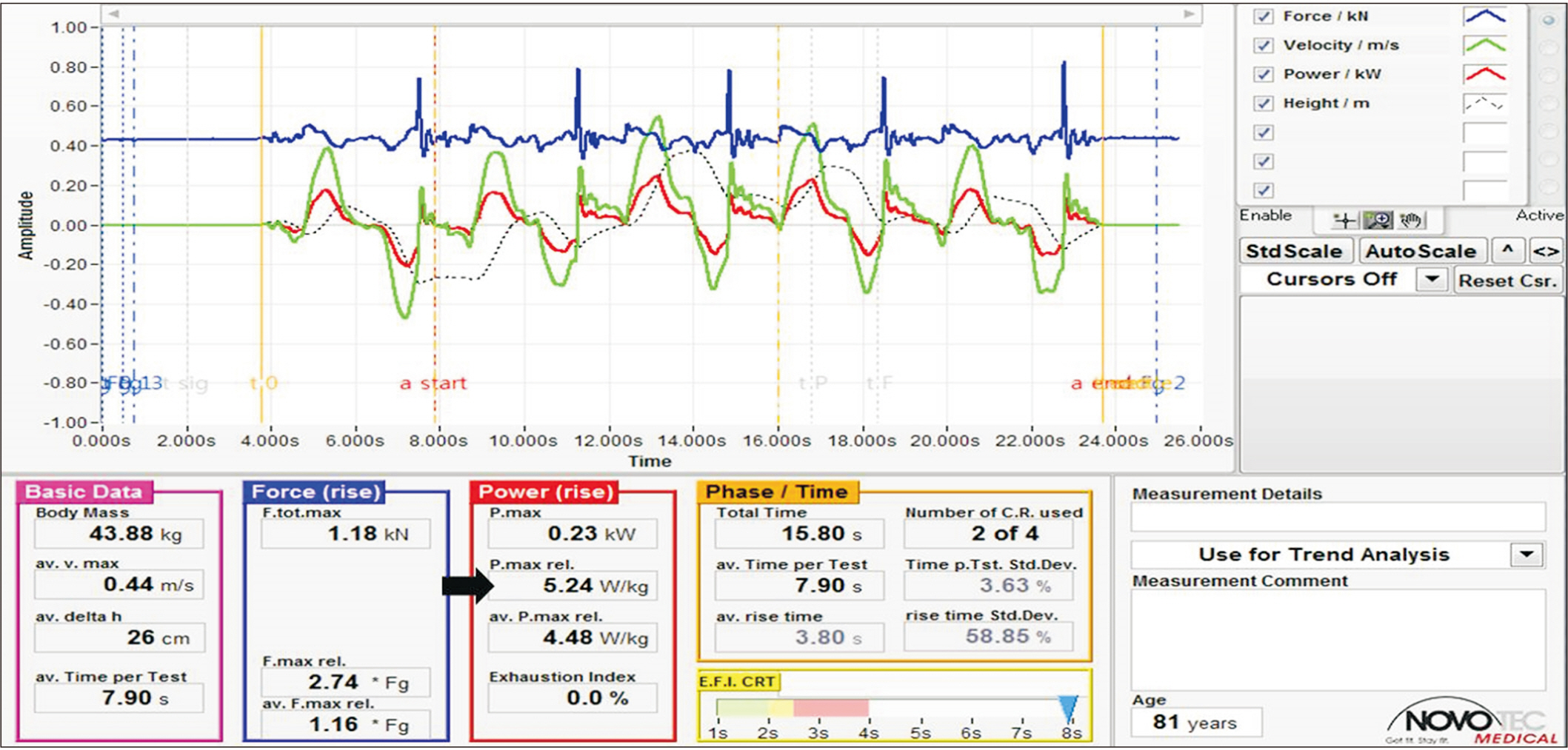Ann Rehabil Med.
2019 Dec;43(6):642-649. 10.5535/arm.2019.43.6.642.
Correlation Between Mechanography and Clinical Parameters at Six Months After Hip Fracture Surgery
- Affiliations
-
- 1Department of Physical Medicine and Rehabilitation, Chung-Ang University Hospital, Chung-Ang University College of Medicine, Seoul, Korea. powe5@cau.ac.kr
- 2Department of Orthopaedic Surgery, Chung-Ang University Hospital, Chung-Ang University College of Medicine, Seoul, Korea.
- 3Department of Rehabilitation Medicine, Seoul National University Bundang Hospital, Seoul National University College of Medicine, Seongnam, Korea.
- KMID: 2468691
- DOI: http://doi.org/10.5535/arm.2019.43.6.642
Abstract
OBJECTIVE
To investigate the correlation between mechanography and clinical parameters in older people at 3 and 6 months after hip fracture surgery.
METHODS
A longitudinal follow-up study was conducted in university hospitals with 38 patients at 3 months and 29 patients at 6 months after hip fracture surgery. Subjects 65 years and older completed measurements on the Berg Balance Scale (BBS), Functional Ambulation Category (FAC), walking ability by Koval, Korean version of the fatigue, resistance, ambulation, illnesses, and loss of weight (K-FRAIL) scale, and hand grip strength. The Romberg test with center of foot pressure (COP), chair rise test (CRT), and maximal power (W/kg) were conducted using the Leonardo Mechanograph.
RESULTS
COP area and pathway length were correlated with BBS at 3 and 6 months. Change in BBS was correlated with change in COP area, but not with change in COP length. COP area and pathway length were correlated with K-FRAIL at 3 months after hip fracture surgery. The same COP variables showed correlations with FAC and walking ability by Koval at 6 months after surgery. Maximal power during CRT had correlation with chair rise time but not with other clinical parameters.
CONCLUSION
The study revealed correlations between mechanography and clinical parameters in older people at 3 and 6 months after hip fracture surgery. Both the clinical assessment and objective test with mechanography may be required for the quantitative and sensitive measurement of postural balance and lower limb muscle power.
MeSH Terms
Figure
Reference
-
1. Lee D, Jo JY, Jung JS, Kim SJ. Prognostic factors predicting early recovery of pre-fracture functional mobility in elderly patients with hip fracture. Ann Rehabil Med. 2014; 38:827–35.
Article2. Santos GM, Souza AC, Virtuoso JF, Tavares GM, Mazo GZ. Predictive values at risk of falling in physically active and no active elderly with Berg Balance Scale. Rev Bras Fisioter. 2011; 15:95–101.
Article3. Radosavljevic N, Nikolic D, Lazovic M, Petronic I, Milicevic V, Radosavljevic Z, et al. Estimation of functional recovery in patients after hip fracture by Berg Balance Scale regarding the sex, age and comorbidity of participants. Geriatr Gerontol Int. 2013; 13:365–71.
Article4. Winter DA, Patla AE, Frank JS. Assessment of balance control in humans. Med Prog Technol. 1990; 16:31–51.5. Li Z, Liang YY, Wang L, Sheng J, Ma SJ. Reliability and validity of center of pressure measures for balance assessment in older adults. J Phys Ther Sci. 2016; 28:1364–7.
Article6. Gray VL, Ivanova TD, Garland SJ. Reliability of center of pressure measures within and between sessions in individuals post-stroke and healthy controls. Gait Posture. 2014; 40:198–203.
Article7. Terra MB, Da Silva RA, Bueno MEB, Ferraz HB, Smaili SM. Center of pressure-based balance evaluation in individuals with Parkinson’s disease: a reliability study. Physiother Theory Pract. 2018; 1–8.
Article8. Fried LP, Tangen CM, Walston J, Newman AB, Hirsch C, Gottdiener J, et al. Frailty in older adults: evidence for a phenotype. J Gerontol A Biol Sci Med Sci. 2001; 56:M146–56.
Article9. Morley JE, Malmstrom TK, Miller DK. A simple frailty questionnaire (FRAIL) predicts outcomes in middle aged African Americans. J Nutr Health Aging. 2012; 16:601–8.
Article10. Jung HW, Yoo HJ, Park SY, Kim SW, Choi JY, Yoon SJ, et al. The Korean version of the FRAIL scale: clinical feasibility and validity of assessing the frailty status of Korean elderly. Korean J Intern Med. 2016; 31:594–600.
Article11. Baker D, Nance S, Moore M. The load that maximizes the average mechanical power output during jump squats in power-trained athletes. J Strength Cond Res. 2001; 15:92–7.
Article12. Smith WN, Del Rossi G, Adams JB, Abderlarahman KZ, Asfour SA, Roos BA, et al. Simple equations to predict concentric lower-body muscle power in older adults using the 30-second chair-rise test : a pilot study. Clin Interv Aging. 2010; 5:173–80.13. Koval KJ, Skovron ML, Aharonoff GB, Meadows SE, Zuckerman JD. Ambulatory ability after hip fracture: a prospective study in geriatric patients. Clin Orthop Relat Res. 1995; (310):150–9.14. Ban B, Sevsek F, Rugelj D. A comparison of the ceiling effect between Berg Balance Scale and Mini-BESTest in a group of balance trained community-dwelling older adults. Physiother Q. 2017; 25:3–9.
Article15. Ganz SB, Peterson MG, Russo PW, Guccione A. Functional recovery after hip fracture in the subacute setting. HSS J. 2007; 3:50–7.
Article16. Chong TW, Chan G, Feng L, Goh S, Hew A, Ng TP, et al. Integrated care pathway for hip fractures in a subacute rehabilitation setting. Ann Acad Med Singapore. 2013; 42:579–84.17. Jo S, Park SB, Kim MJ, Kim T, Park KI, Sung J, et al. Comparison of balance, proprioception and skeletal muscle mass in total hip replacement patients with and without fracture: a pilot study. Ann Rehabil Med. 2016; 40:1064–70.
Article18. Rasch A, Dalen N, Berg HE. Muscle strength, gait, and balance in 20 patients with hip osteoarthritis followed for 2 years after THA. Acta Orthop. 2010; 81:183–8.
Article19. Judd DL, Dennis DA, Thomas AC, Wolfe P, Dayton MR, Stevens-Lapsley JE. Muscle strength and functional recovery during the first year after THA. Clin Orthop Relat Res. 2014; 472:654–64.
Article20. Palmieri RM, Ingersoll CD, Stone MB, Krause BA. Center-of-pressure parameters used in the assessment of postural control. J Sport Rehabil. 2002; 11:51–66.
Article21. Thompson LA, Badache M, Cale S, Behera L, Zhang N. Balance performance as observed by center-of-pressure parameter characteristics in male soccer athletes and non-athletes. Sports (Basel). 2017; 5.
Article22. Ambrose AF, Paul G, Hausdorff JM. Risk factors for falls among older adults: a review of the literature. Maturitas. 2013; 75:51–61.
Article
- Full Text Links
- Actions
-
Cited
- CITED
-
- Close
- Share
- Similar articles
-
- Intertrochanteric fracture associated with posterior hip dislocation
- Orthopaedic Surgical Treatment of Hip Fractures
- Iatrogenic Proximal Tibiofibular Fracture during Manual Reduction of Posterior Hip Dislocation After Total Hip Arthroplasty
- Reliability of the Radiologic Measurement Methods for Assessment of Osteoporosis Using the Digital Hip Radiograph
- Total hip arthroplasty in unreduced fracture dislocation of the hip





